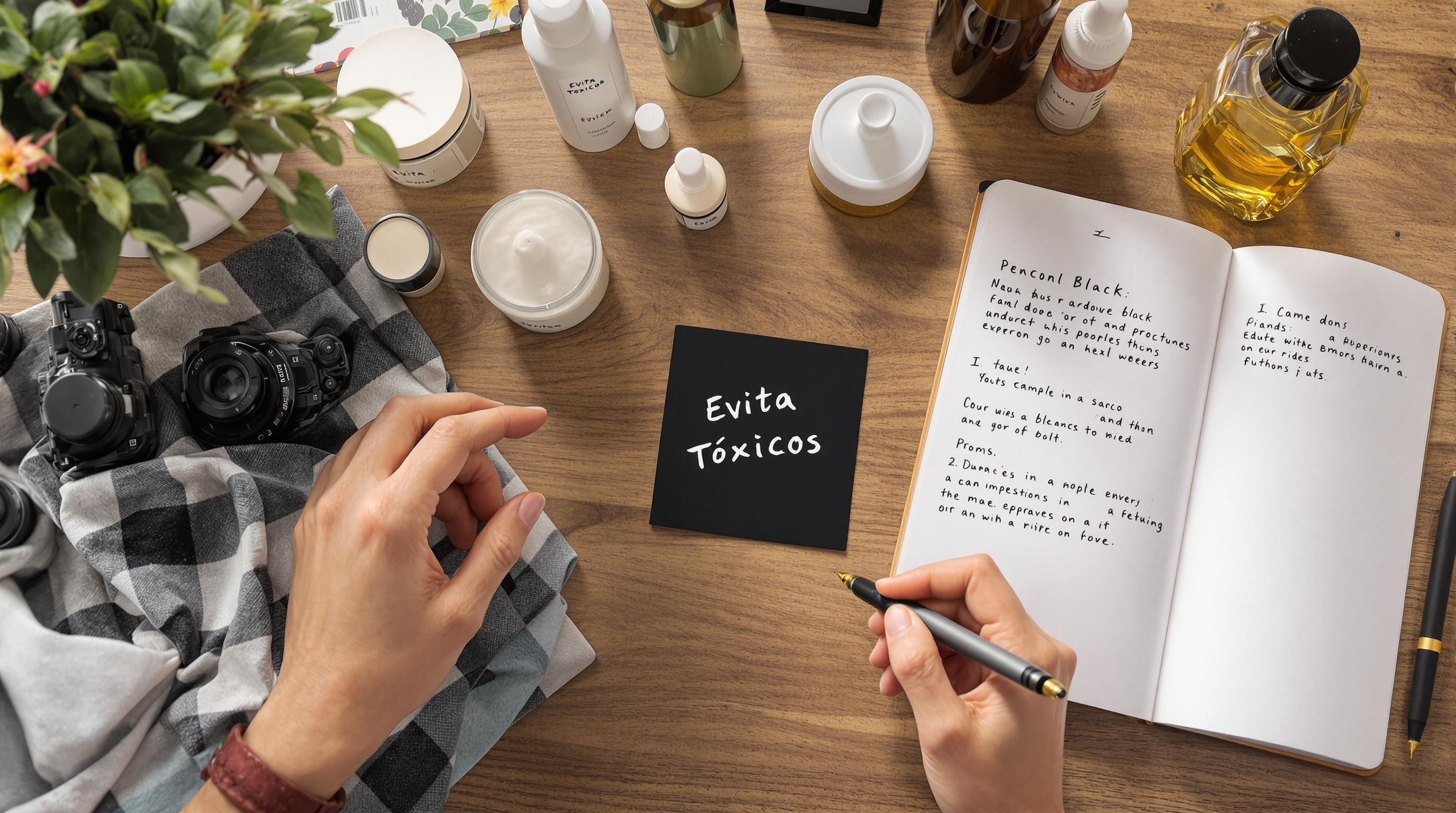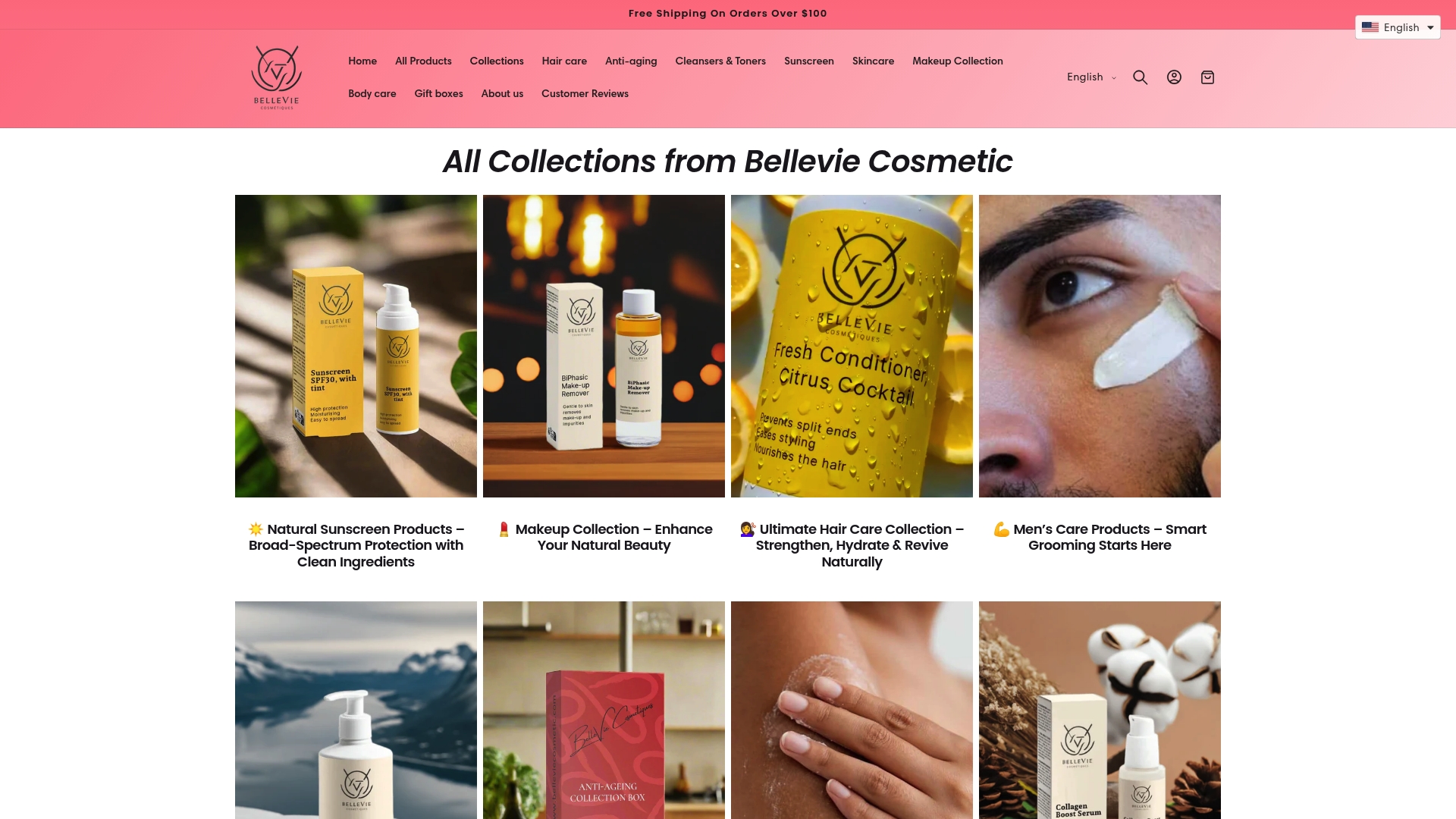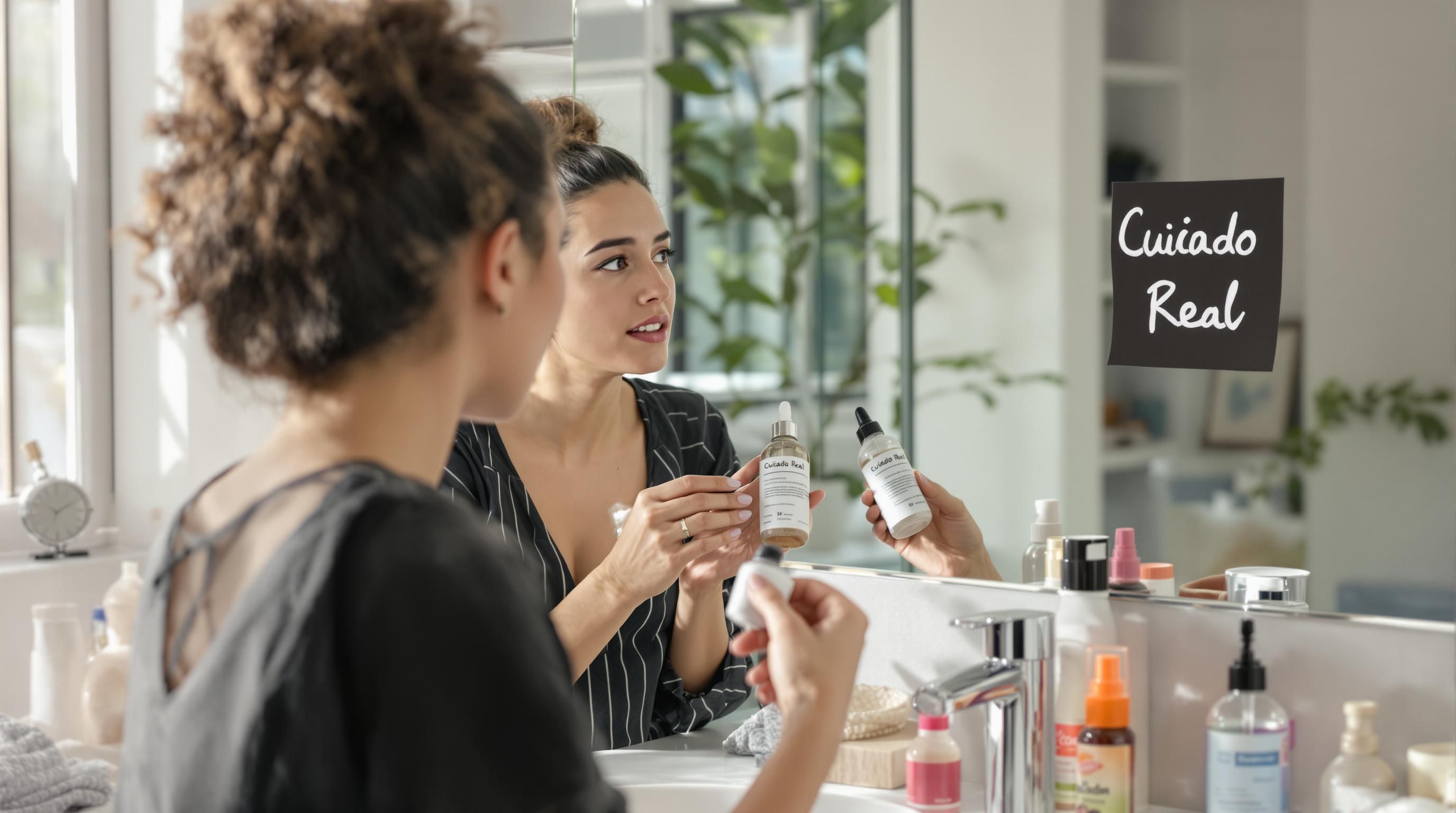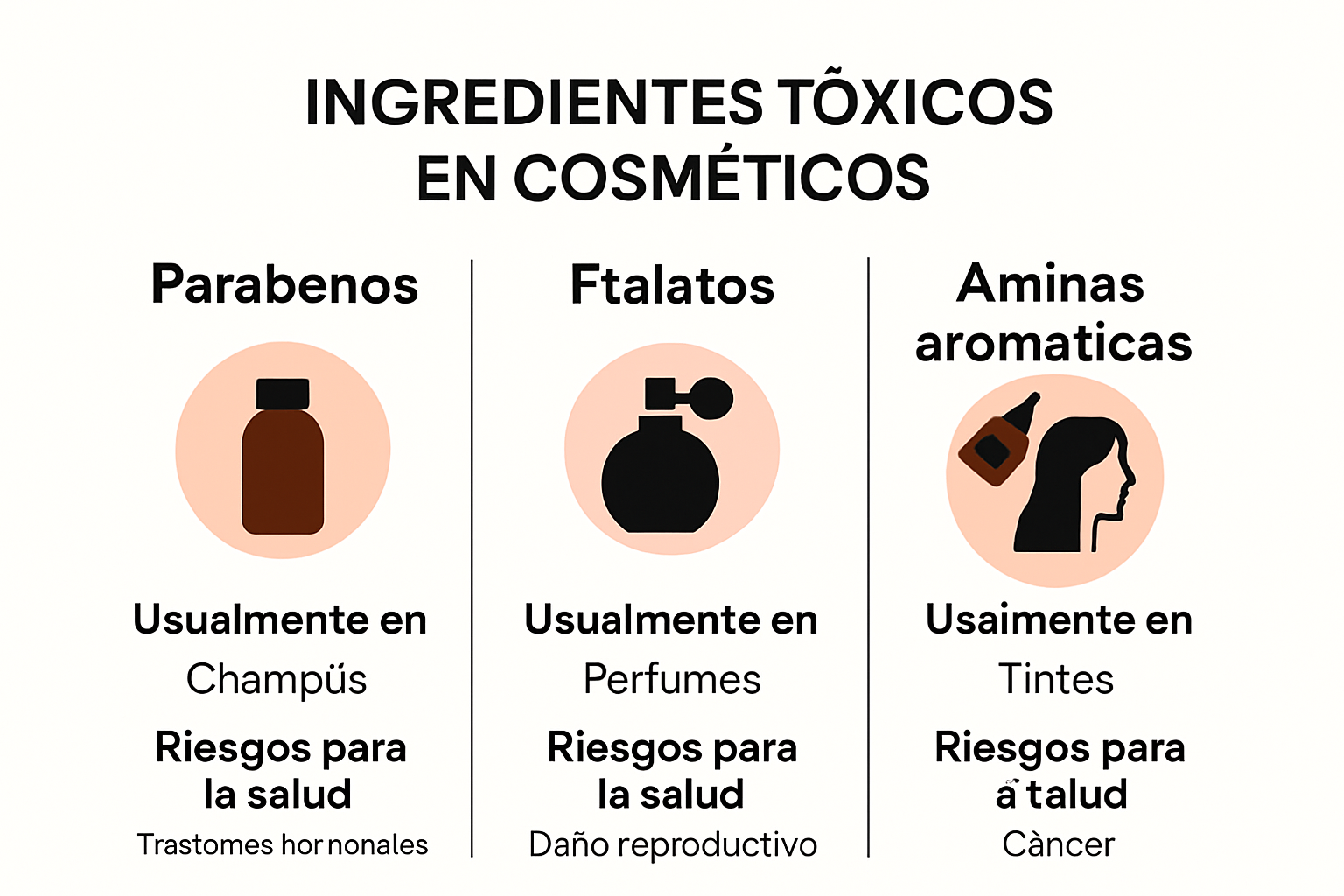La mayoría de los cosméticos convencionales parecen inofensivos y coloridos en sus envases. Sin embargo, lo que muchos desconocen es que más del 60% de los productos de belleza populares contienen ingredientes asociados con riesgos para la salud. A pesar de lo común que es encontrar parabenos, ftalatos o formaldehído en el etiquetado, lo verdaderamente sorprendente es que basta una pequeña dosis diaria para que estos componentes afecten tu piel y tu bienestar a largo plazo. Elegir productos más limpios y leer las etiquetas puede marcar la diferencia entre una rutina de belleza segura y una exposición innecesaria a sustancias tóxicas.
Table of contents
- What are toxic ingredients in cosmetics?
- Lista de ingredientes tóxicos comunes a evitar
- Alternativas seguras y efectivas en cosmética clean
- Cómo identificar productos libres de tóxicos y cuidar tu piel sensible
Quick Summary
| Conclusion | Explanation |
|---|---|
| Evita ingredientes nocivos en cosméticos | Conoce y evita parabenos, ftalatos y formaldehído, que pueden dañar tu salud. |
| Opta por cosmética limpia | Choose products that use natural and safe ingredients to care for your skin. |
| Read labels carefully | Learn to identify toxic ingredients and look for safety seals on products. |
| Choose hypoallergenic products | Prefer cosmetics designed for sensitive skin, minimizing the risk of adverse reactions. |
| Consult a dermatologist | Seek professional guidance to select products suitable for your skin needs. |
What are toxic ingredients in cosmetics?
Toxic ingredients in cosmetics are potentially harmful chemical substances commonly found in personal care and beauty products. These components can pose significant risks to human health, causing anything from simple skin irritations to more complex health issues.
Definition and Main Characteristics
Toxic ingredients are characterized by their ability to cause harmful effects in the body even in small amounts. According to the American Cancer Society, some of these ingredients may be associated with hormonal disruptions, skin problems, and potential long-term risks.
Some elements considered toxic include:
- Parabens: Preservatives that can interfere with hormonal systems
- Phthalates: Chemicals that can affect reproductive function
- Formaldehyde: Preservative linked to cancer risks
Health Impact Mechanisms
When these toxic ingredients come into contact with our skin, they can be absorbed by the body through different routes. The risk depends not only on the individual substance but also on cumulative exposure and concentration.
The effects can manifest in various ways:
- Skin irritation and allergies
- Hormonal imbalances
- Potencial acumulación de sustancias nocivas en los tejidos
Es fundamental comprender que no todos los ingredientes químicos son perjudiciales. La toxicidad depende de múltiples factores como concentración, exposición y composición específica. Sin embargo, la tendencia actual en la industria cosmética apunta hacia formulaciones más naturales y seguras.
Los consumidores conscientes pueden protegerse leyendo etiquetas, investigando ingredientes y optando por productos elaborados con componentes más seguros y transparentes. La clave está en la información y la elección informada sobre los productos que utilizamos en nuestra rutina de cuidado personal.
Lista de ingredientes tóxicos comunes a evitar
Los cosméticos pueden contener numerosos ingredientes potencialmente perjudiciales para la salud. Conocer estos componentes es fundamental para tomar decisiones informadas sobre los productos de cuidado personal que utilizamos diariamente.
Ingredientes Químicos Más Peligrosos
Según la FDA, existen varios ingredientes que representan riesgos significativos para la salud humana. Entre los más preocupantes se encuentran:
- Parabenos: Conservantes que pueden alterar el sistema hormonal
- Ftalatos: Sustancias químicas asociadas con problemas reproductivos
- Formaldehído: Preservante clasificado como potencial carcinógeno
- PFAS: Sustancias químicas que pueden acumularse en el organismo
Sustancias Específicas a Evitar
El Grupo de Trabajo Ambiental (EWG) recomienda prestar especial atención a los siguientes ingredientes:
- Compuestos de Mercurio: Extremadamente tóxicos para el sistema nervioso
- Cloruro de Vinilo: Sustancia asociada con riesgos cancerígenos
- Cloroformo: Químico potencialmente dañino
- Triclosan: Conservante con posibles efectos hormonales
- Diethyl Phthalate: Chemical that can interfere with the endocrine system
These ingredients can be found in various cosmetic products, from makeup to moisturizers. Prolonged exposure can cause health problems ranging from skin irritations to more serious disorders.

Below is a comparative table summarizing the most common toxic ingredients in cosmetics, their uses, and associated risks, to facilitate identification and understanding.
| Ingredient | Common use | Health risks |
|---|---|---|
| Parabens | Preservative | Hormonal disruptions |
| Phthalates | Plasticizer, fragrance fixer | Reproductive, endocrine issues |
| Formaldehyde | Preservative | Potential carcinogen |
| PFAS | Waterproofing, smooth finish | Accumulation in the body, various risks |
| Mercury Compounds | Whiteners, antiseptics | Nervous toxicity, kidney damage |
| Vinyl Chloride | Plasticizer (rare) | Carcinogenic risk |
| Chloroform | Solvent (rare) | Liver damage, possible carcinogen |
| Triclosán | Antimicrobial | Hormonal alterations, bacterial resistance |
| Diethyl Phthalate | Solvent, fragrance | Endocrine disruption |
It is important to remember that not all chemical ingredients are harmful. The key lies in concentration, exposure, and understanding their possible effects. Conscious consumers should:
- Carefully read product labels
- Research ingredients before buying
- Opt for brands that prioritize natural and safe ingredients
- Consult with health professionals about possible reactions
The cosmetics industry is evolving towards safer and more transparent formulations. More and more brands are committed to eliminating toxic ingredients and offering more natural and healthy products. As consumers, we have the power to choose products that care for our health and well-being in the long term.
Safe and effective alternatives in clean cosmetics
Clean cosmetics represent a revolution in personal care, offering solutions that prioritize health and well-being without compromising product efficacy. This trend seeks to replace toxic ingredients with natural and safe alternatives.
High-Performance Natural Ingredients
According to a study published in the International Journal of Environmental Research and Public Health, there are multiple natural alternatives that can effectively replace traditional synthetic ingredients. Some of the most notable components include:
- Aceites vegetales: Como jojoba, argán y rosa mosqueta, que ofrecen hidratación profunda
- Botanical extracts: Providing antioxidant and soothing properties
- Natural minerals: Such as zinc oxide and titanium dioxide for sun protection
Natural Preservatives and Conservants
Traditional preservatives can be replaced by safer alternatives:
- Rosemary oil: Acts as a natural antioxidant
- Vitamin E: Prevents rancidity in formulations
- Tocopherol: Effective alternative to parabens
Consumers can identify these ingredients by looking for products labeled as “clean beauty,” “toxin-free,” or with specific natural ingredient certifications. Transparency in labeling is essential for making informed decisions.
Clean cosmetics is not just about removing harmful ingredients, but about creating formulations that nourish and protect the skin comprehensively. This involves considering not only immediate safety but also long-term impacts on health and the environment.
Below is a comparative table with natural and clean alternatives to replace hazardous synthetic ingredients, along with their benefits and typical applications.
| Clean alternative | Synthetic ingredient replaced | Main benefit | Typical application |
|---|---|---|---|
| Rosemary oil | Parabens | Natural preservative, antioxidant | Creams, serums, and shampoos |
| Vitamin E (Tocopherol) | Parabens | Prevents rancidity, protects skin | Oils, balms, creams |
| Jojoba oil | Silicones/Synthetics | Hydration, sebum regulation | Facial and body creams |
| Zinc oxide | Chemical UV filters | Sun protection, soothing | Sunscreens, makeup |
| Aloe vera extract | Synthetic fragrances | Soothes irritations, hydrates | After sun, facial creams |
| Botanical extracts | Synthetic colorants | Antioxidant, protection | Creams, tonics, and lotions |
Some recommendations to adopt a clean beauty routine include:
- Research brands committed to natural ingredients
- Read labels carefully
- Try products with sustainability certifications
- Prioritize transparent brands regarding their manufacturing process
Es importante recordar que “natural” no siempre significa automáticamente seguro. Cada piel es única y puede reaccionar de manera diferente a los ingredientes. Siempre es recomendable realizar una prueba de parche antes de incorporar nuevos productos a la rutina de cuidado personal.
La industria cosmética continúa evolucionando, con más marcas comprometidas en desarrollar productos que sean efectivos, seguros y respetuosos con el medio ambiente. Los consumidores tienen ahora más opciones que nunca para cuidar su piel de manera consciente y responsable.
Cómo identificar productos libres de tóxicos y cuidar tu piel sensible
Cuidar la piel sensible requiere atención especial y conocimiento sobre los ingredientes de los productos cosméticos. Identificar formulaciones seguras es fundamental para mantener una piel saludable y protegida.
Estrategias para Leer Etiquetas de Manera Inteligente
Según la FDA, es crucial aprender a leer y comprender las etiquetas de los productos cosméticos. Las personas con piel sensible deben prestar especial atención a:
- Lista de ingredientes: Buscar nombres de sustancias químicas conocidas como tóxicas
- Certificaciones: Sellos que garanticen productos libres de sustancias nocivas
- Declaraciones de seguridad: Información sobre pruebas dermatológicas
Identificación de Productos Seguros para Pieles Sensibles
Los Institutos Nacionales de Salud (NIH) recomiendan tomar precauciones adicionales al seleccionar productos cosméticos:
- Evitar fragancias artificiales: Pueden causar irritaciones
- Preferir productos hipoalergénicos: Diseñados para minimizar reacciones
- Buscar ingredientes calmantes: Como aloe vera y pantenol
- Realizar pruebas de parche: Verificar reacciones antes del uso completo
Consejos Adicionales para Proteger Pieles Sensibles
El Programa de Estilo de Vida Anticáncer ofrece estrategias complementarias para cuidar pieles delicadas:
- Priorizar productos con ingredientes orgánicos certificados
- Consultar con dermatólogos sobre productos adecuados
- Mantener una rutina de cuidado minimalista para la piel
- Make gradual changes in products
People with sensitive skin should be especially cautious. Skin reactivity can manifest through:
- Redness
- Itching
- Burning sensation
- Peeling
It is essential to understand that every skin is unique. What works for one person may not be ideal for another. Responsible experimentation, accompanied by careful observation, is key to finding the right products.
Always recommending a consultation with a dermatology professional allows for personalized guidance. Specialists can perform specific tests to identify sensitivities and recommend treatments tailored to individual needs.
Technology and research continue to advance in developing safer and more effective cosmetics. Staying informed, being patient with your skin, and choosing products with quality ingredients are the best allies to keep sensitive skin healthy and protected.
Frequently Asked Questions
What are toxic ingredients in cosmetics?
Toxic ingredients in cosmetics are chemical substances that can cause health damage, including skin irritations and hormonal problems. Some examples are parabens and phthalates.
How can I identify toxin-free cosmetic products?
To identify toxin-free products, it is essential to read labels carefully, look for safety seals, and choose hypoallergenic products with natural ingredients.
What are the most dangerous chemical ingredients in cosmetics?
The most dangerous chemical ingredients include parabens, phthalates, formaldehyde, and mercury compounds, which can pose significant health risks.
What alternatives exist to toxic ingredients in cosmetics?
There are multiple natural alternatives, such as vegetable oils, botanical extracts, and natural preservatives, that can replace toxic ingredients without compromising product effectiveness.
Take the leap to a toxin-free routine with BelleVie
Worried about dangerous ingredients hiding in your cosmetics? We know choosing safe products can feel overwhelming, especially if you have sensitive skin or are tired of components like parabens, phthalates, or formaldehyde that harm your skin and health long-term. You deserve trust and real results at every step of your personal care routine.

Discover a transparent and effective alternative with BelleVieCosmetic.com. Here you will find certified, natural products without harmful chemicals. Explore our full clean beauty collection, choose your next favorite, and feel the difference of cosmetics that care for your well-being. Decide to take care of yourself today and make healthy skin your new reality.
Recomendado
- Aceites faciales para una piel radiante 2025 – BelleVie Organic – BelleVie Cosmétiques
- Aceites faciales para una piel radiante 2025 – BelleVie Organic – BelleVie Cosmétiques
- Aceites faciales para una piel radiante 2025 – BelleVie Organic – BelleVie Cosmétiques
- Ventajas clave del cuidado de la piel casero en 2025 para una piel saludable – BelleVie Cosmétiques


